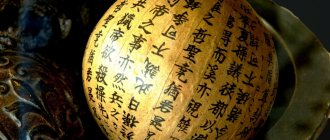China has been a multi-religious country since ancient times. It is well known that Confucianism is the indigenous religion of China and is the soul of Chinese culture. Confucianism enjoys popular support and even became the guiding ideology of feudal society, but it will not become the national religion of China.
According to the latest survey, 85% of Chinese people have religious beliefs, some have religious practices and only 15% of them are actual atheists. (Real atheists here refer to those who do not believe in any religion, or in any activities associated with religions or folk customs.) 185 million people practice Buddhism, 33 million people are Christians or Catholics and believe in the existence of God .
And only 12 million people profess Taoism. Thus, it can be seen that Buddhism has the most widespread influence than the other major religions of China: Taoism, Confucianism, Islam and Christianity.
Which 2 religions are the main ones in China?
Among modern Chinese, two religious movements are the most popular - Taoism and Confucianism.
Confucianism
This Chinese religion appeared in the 6th century. BC. The great philosopher Confucius is recognized as the progenitor of this movement, but two other thinkers who also made a significant contribution to its development cannot be crossed out: Mencius and Sun Tzu. Their treatises also became the basis for the development of this religion.
Confucianism describes the relationship between:
- Parents and children.
- Ruler and subjects
- Brother and brother.
- Friends.
- Husband and wife.
In the old days, the study of Confucianism was always considered aristocratic. This doctrine was supported by the imperial dynasty of China. The main idea of Confucianism is the humanization of the entire established society, where each person has his own place in the established social structure. Adherence to this cult instills in people a desire for goodness, mercy, honor and devotion. It remains relevant today and is quite common in various parts of the world.
Fact. In China, this movement is called the “school of scientists.” “Confucianism” is a purely Western concept with no precise translation in Chinese.
Taoism
This movement arose almost at the same time as Confucianism in northern China. The ancient philosopher Lao Tzu is recognized as the founder. The main idea of the movement is to move along the path of Tao, to fulfill its canons. This is the course of all world events. They obey his will, and this activates the development of all aspects of people’s lives, the entire Universe.
Taoists believe in the immortality of the human soul. The main idea of Tao is not to resist the process, but to merge with it, to enter into a single rhythm.
Fact. Some researchers still do not consider Confucianism and Taoism to be full-fledged Chinese religions, classifying them only as philosophical teachings.
Buddhism
This religion came from India much earlier than other external spiritual movements. This teaching is more adapted to the life of the Chinese and is therefore more widespread throughout the territory. Afghan and Indian craftsmen created real temples in the mountains and rocks of China, and later images of Buddha were also carved by local craftsmen. In the Celestial Empire, Buddhism acquired its own features characteristic of China, which are not characteristic of the Indian direction. The majority of Buddhists in China are Han Chinese, the largest ethnic group in China.
The main thing in Buddhism is achieving the state of nirvana as a result of strict adherence to all rules and spiritual experiences. Submission and self-sacrifice for the sake of reparation for sins is the goal of the followers of this religion. The main attention is directed to cleansing the human soul from anger and cowardice. Karma forces people to search for the right solution throughout their lives.
Islam
Islam penetrated into the Celestial Empire along with Arab preachers and merchants. In addition, the influx of some peoples (Kazakhs, Uighurs) also contributed to the spread of this movement. Today in the PRC there is a Chinese Muslim Association, created for the development of Islam and cooperation with world organizations. There are approximately 60 million Muslims in the country, most of them live in the Western regions of the country.
Christianity
The first Christians appeared in the Middle Kingdom in the 7th century. AD represented by Nestorian missionaries. The most widespread branches of this religion in China are:
- Orthodox Church,
- Catholicism,
- Protestantism
- and others, there are approximately 80 million Christians in total.
Orthodoxy
Representatives of Orthodoxy have been present in the PRC for a long time, dating back to the times of the Golden Horde, when Russian military leaders served at the court of one of the Tatar-Mongol cities - Khan Balyk, present-day Beijing. From the 17th century adherents of the Orthodox Church lived in the Middle Kingdom permanently, mainly in the northern border provinces, represented by prisoners, traders, and ambassadors.
At the end of the 17th century. captured Russian Cossacks created an Orthodox community in Beijing at the beginning of the 18th century. To support them and strengthen international cooperation, the Russian Spiritual Mission was created.
Today, about 15 thousand Orthodox Christians live in China. As a national minority religion, it is recognized in certain regions - Xinjiang, Heilongjiang and others.
Catholicism
The first Catholics appeared in the Middle Kingdom in the 7th century. AD, but the most widespread spread of this movement occurred in the 19th century, after the Opium Wars. Now in the PRC there are more than a hundred parishes, 5,000 churches, and approximately 5 million people profess Catholicism.
Fact. The number of Christians in China is about 100 million people, which exceeds the number of communists in the country.
Religion of Ancient China
The religion of Ancient China recognizes a supreme being - Tian; He is personified on earth by the supreme ruler Shan Di. Nevertheless, this religion is very far from pure monotheism, but rather recognizes that nature is full of heavenly, earthly and human spirits , which, as such, have influence and are revered.
The first include the sun, moon, planets and individual constellations; to the second - mountains, seas, streams, rivers, springs, trees, etc.; in addition, there is a special patron spirit of the state and the spirits of the earth: first for each individual principality, then for each city and town - the patron spirits of agriculture, hearth crops, etc.; to the third. finally, the spirits of deceased family members belong, i.e. ancestors and spirits of outstanding people.
The gods of China can be the embodiment of cosmogonic and chthonic forces - personifying the natural power of the earth. In this religion there were and are no persons of clergy rank: the emperor is its high priest, who enjoys the right of sacred rites and prayer in the Temple of Heaven, but only in person; in other temples he can temporarily or permanently replace himself with officials. As emperor and father of the people, he accepts responsibility before heaven for the behavior of his subjects and sees in the people's disasters the consequences of his sinfulness.
Interaction of religious cults in China with the state
Freedom of religion is constitutionally enshrined in the PRC. All religious movements have reached the present time and are supported by their adherents.
The policy of the country's leadership has always been associated with beliefs. During the reign of the Empire, the ideas of Confucius were most supported, because one of their postulates was service to one’s state and the preservation of the existing system. The adherents of Taoism were mainly peasants and ordinary workers.
The ruling dynasty in all directions was based on spiritual trends, most political actions were based on them.
Faith was actively used as a tool of general political propaganda. Foreign missionaries and preachers used it for their own purposes.
In modern China, religion is recognized as a separate sphere of life of the population. The PRC is a large multinational state system, and the influence of faith on the policies pursued by the country's leadership is becoming ineffective.
Confucianism: or how to become a “noble husband”
Of all the religious and philosophical teachings, Confucianism (or Lun Yu) experienced rise and fall, ascension to the rank of religion and violent persecution by the authorities. Originating in the 5th - 6th centuries BC. e. This teaching, which was initially considered a social and ethical direction, aimed at the formation of a “noble husband”, a devoted servant of the state. Turning to human nature, Confucianism called on the latter to understand heavenly predestination and humanity. Based on the knowledge of the “heavenly” in man, Confucianism acquires religious features, becoming the main religion of the Chinese state. The teachings about the spirit, the innermost and secret, about heaven or the supernatural, determined the religious component of Confucianism.
Confucianism receives its greatest fame and recognition 300 years after the death of the founder. This determined the entire history of China for 2 thousand years. Not a single area, be it culture, politics, economics or social relations, was without the strong influence of the teachings of Confucius.
History dictated its conditions and, naturally, the teaching was subject to changes. Various schools, entire directions appeared, which interpreted Confucius in different ways according to the time. Neo-Confucianism and, most recently, post-Confucianism emerge. With the formation of the People's Republic of China in 1949, Confucianism was completely criticized and replaced by communist ideology.
Today, communist China is considering bringing back the ideas of Confucius. Surely, this will be the right decision, since the moral code of the builder of communism in many respects coincides with the idea of a “noble husband”.
According to various sources, approximately 12% of Chinese adhere to Confucianism.
Reasons for the widespread spread of religious cults in China
Some widespread spiritual movements arose within China itself - these are Taoism and Confucianism, others penetrated from outside: Christianity, Islam, Buddhism. In addition, in some remote provinces, polytheism and the worship of various forces of nature, which was the official religion of the Celestial Empire before the spread of Confucianism, Buddhism and Taoism, still persist.
The most ancient religions - Confucianism, Tao and Buddhism, developing over many centuries, successfully combined with each other, each of them found its own place in the general system of religions of China. The principles of Confucianism were used in relationships between people, Taoism - in the sphere of human feelings, Buddhism helped correct sins, and supported dreams of a bright future.
The existing system of Chinese religions was formed primarily at the lower level of the social hierarchy, in the form of superstitions, traditions and customs. The poor Chinese did not even distinguish individual religions, but turned to all gods at once.
Confucianism
Confucianism is an ethical, philosophical system that was founded by Confucius. It gained its stable position during the reign of Emperor Wu of the Han Dynasty (202BC-220AD), and became the ideology of society, it was considered as a system for educating the people. He achieved a stable position during the feudal system.
Traditions and principles in Confucianism play an important role in shaping the thinking patterns and teaching methods of the Chinese people.
Confucianism has influence throughout the world. In many countries and regions of the world, such as the UK and the USA, there are branches of Confucius Institutes, which have been created in recent years of the spread of Chinese culture and the expansion of language knowledge. In China, you can find many Confucius temples.
The main reasons for the influx of foreign religious movements into China
There are several main reasons:
- The Great Silk Road.
This is the most significant trade route in the ancient world, through which people carried not only goods, but also thoughts, ideas, and beliefs. So the population of China was able to learn about the religious cults of other peoples, customs, and traditions.
- Migration.
The modern Chinese population was formed as a result of significant migration influxes from other territories. Each ethnic group brought its own culture, language, and religion. As a result of the movement of many nations, a single system of religion was formed, consisting of various cults.
- Political and historical events.
The PRC, both in ancient times and now, has always been of significant interest to other countries. Since the times of the Golden Horde, the Mongols have tried to conquer this state and introduce their religion. Subsequently, becoming one of the most actively developing countries in the world, it attracted leaders of other states who tried to expand their influence through religion.
- Targeted campaigning.
Since the 7th century. Preachers of external religions - Catholicism, Islam, Orthodoxy - began to appear in the PRC. They carried out active work, not always successfully, but persistently repeating attempts. As a result, many churches, mosques, temples, and sanctuaries of various kinds have been opened throughout the country.
Taoism: an alternative to Confucianism or the basis of life
About 20% of Chinese residents believe in Taoism.
According to historical sources, the founder of Taoism in China was Lao Tzu. There are suggestions that the founder of the teachings of Tao (or Tao Te Ching), which arose in parallel with Confucianism, is Emperor Huangdi. Considering the fact that the Chinese emperors were well acquainted with various philosophical teachings, it can be assumed that Huangdi made some additions or clarifications to the teachings of Tao. This religion found its supporters in China and at one time developed successfully. Again, it is necessary to clarify that Taoism is more of a philosophical and moral teaching than a religion.
Taoism or the "Way of Things" represented man as a part of nature or a microcosm, a substance. Tao is the universal law or absolute, the beginning of everything and the end point. Human happiness lies in the knowledge of Tao. The goal of human life is to understand oneself through contemplation and meditation. It is immersion in one’s “I” that is the meaning of the power of human consciousness.
Taoism became the meaning of the activities of the masses or hermits. From time to time, various ideas arose in Taoism that inspired scientists and politicians, religious leaders and philosophers.
Taoism was supposed to be an alternative to Confucianism. Indeed, in the first case we are talking about internal contemplation, and in the second - service to the state. Based on a historical assessment, Taoism was unable to resist Confucianism with its teachings, since it separated the individual from the world, from society. But still, the merit of the teachings of Tao is an attempt at a deep ascent into the world of consciousness. In this respect, Taoism is similar to the teachings of Buddhism.
Pilgrimage centers in China
They are divided by type of religion:
Buddhism
- temple in Shanghai,
- Yonghe Temple in Beijing,
- Xi'an Big Goose,
- Chongqing reliefs,
- Sichuan Mount Emei.
Christian directions:
- Cathedral of St. Ignatius in Shanghai,
- Church of St. Sofia in Harbin,
- Church of St. John in Hong Kong.
Taoism:
- Shandong Mount Tai,
- Anhui Yellow Mountains,
- Temple of the Guardian Goddess in Shanghai.
Islam:
- Xi'an Mosque,
- Idgar Mosque in Kashgar,
- Kuchan Mosque.
Confucianism:
- Shandong Exhibition Complex,
- Nanjing quarter.
Important Features of Chinese Religions
The Chinese Communist Party does not restrict religious freedom. This right is constitutionally enshrined, which confirms the desire of the country's leadership to maintain its influence in Chinese society. For residents of the Celestial Empire, it is extremely important to belong to one religion or another. This is a feature of mentality and character.
The specificity of China is the close intertwining of philosophy and religion. The indigenous population of China professes not only the above traditional beliefs. Many Chinese visit Catholic and Protestant churches and mosques. In this or that city, the religious picture is very varied.
Interestingly, the exact number of believers in China is unknown. The atheistic lifestyle and the influence of the party did not interfere with the performance of cults and rituals. However, many Chinese do not consider themselves followers of a particular religion.
For 5 thousand years, not a single belief or religious movement has become dominant in China. World religions, having penetrated the Celestial Empire, changed under the influence of ancient culture and traditions. As a result, they acquired features characteristic only of China.
Religious composition of China
According to a survey conducted by the special analytical agency WIN, about half of the Chinese (47 percent) call themselves atheists, another 30 consider themselves to be non-religious. This is explained by the action of state policy at the stage of formation of the socialist system, and later during the “Cultural Revolution”, when religion experienced real persecution from the government. But only 15 percent of those living in China can be classified as absolute atheists, who do not believe in any religion and do not perform rituals and customs.
Fact. Most of the absolute atheists in the world live in China.
According to the results of surveys conducted already in the 21st century, the religious composition of the country's citizens is as follows: approximately 80 percent of those living in China observe customs associated with folk and Taoist teachings; 10-15 percent profess Buddhism; 3-4 - followers of Christianity, 1.5-2 - followers of Islam. Therefore, Taoism can be recognized as the main religion of China.
Buddhism
Gradually, Buddhism became the main religion of the Celestial Empire. The latest survey shows that 31% of people who do not believe in Buddhism have taken part in a number of Buddhist events and about 17 million people have already begun to come to faith.
Now the majority of followers are representatives of various classes - the intelligentsia, the business elite, and ordinary people. Recently, a new report has emerged - the 2012 White Paper, published jointly by the Industrial Bank and the Hurun Report, which shows that 39% of intellectuals and businessmen profess Buddhism. Not only the number of followers is growing, but also attention from society. Now in the Celestial Empire there are about 13,000 temples and 180 thousand monks and nuns.
Interesting! Khan Buddhism - 8400 temples and 50 thousand monks - is the largest movement in Buddhism. Tibetan Buddhism ranks second in its prevalence in China - it has 3,000 Temples and 120 thousand monks. Southern Buddhism - 1,600 temples and 8,000 monks - is the least widespread in China.









